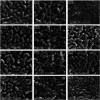Biosorption and bioaccumulation characteristics of cadmium by plant growth-promoting rhizobacteria
- PMID: 35548749
- PMCID: PMC9085637
- DOI: 10.1039/c8ra06270f
Biosorption and bioaccumulation characteristics of cadmium by plant growth-promoting rhizobacteria
Abstract
Plant growth-promoting rhizobacteria (PGPR) not only promote growth and heavy metal uptake by plants but are promising biosorbents for heavy metals remediation. However, there exist arguments over whether extracellular adsorption (biosorption) or intracellular accumulation (bioaccumulation) play dominant roles in Cd(ii) adsorption. Therefore, three cadmium-resistant PGPR, Cupriavidus necator GX_5, Sphingomonas sp. GX_15, and Curtobacterium sp. GX_31 were used to study bioaccumulation and biosorption mechanisms under different initial Cd(ii) concentrations, using batch adsorption experiments, desorption experiments, scanning electron microscopy coupled with energy dispersive X-ray (SEM-EDX) spectroscopy, transmission electron microscopy (TEM), and Fourier-transform infrared (FTIR) spectroscopy. In this study, with the increase of the initial Cd(ii) concentrations, the removal efficiency of strains decreased and the adsorption capacity improved. The highest Cd(ii) removal efficiency values were 25.05%, 53.88%, and 86.06% for GX_5, GX_15, and GX_31 with 20 mg l-1 of Cd(ii), while the maximum adsorption capacity values were 7.97, 17.13, and 26.43 mg g-1 of GX_5, GX_15, and GX_31 with 100 mg l-1 of Cd(ii). Meanwhile, the removal efficiency and adsorption capacity could be ordered as GX_31 > GX_15 > GX_5. The dominant adsorption mechanism for GX_5 was bioaccumulation (50.66-60.38%), while the dominant mechanisms for GX_15 and GX_31 were biosorptions (60.29-64.89% and 75.93-79.45%, respectively). The bioaccumulation and biosorption mechanisms were verified by SEM-EDX, TEM and FTIR spectroscopy. These investigations could provide a more comprehensive understanding of metal-bacteria sorption reactions as well as practical application in remediation of heavy metals.
This journal is © The Royal Society of Chemistry.
Conflict of interest statement
There is no conflict of interest and all the authors are interested to publish the manuscript.
Figures






Similar articles
-
Adsorption of Cd (II) by a novel living and non-living Cupriavidus necator GX_5: optimization, equilibrium and kinetic studies.BMC Chem. 2023 Jun 14;17(1):54. doi: 10.1186/s13065-023-00977-4. BMC Chem. 2023. PMID: 37316907 Free PMC article.
-
Adsorption of cadmium by live and dead biomass of plant growth-promoting rhizobacteria.RSC Adv. 2018 Oct 1;8(58):33523-33533. doi: 10.1039/c8ra06758a. eCollection 2018 Sep 24. RSC Adv. 2018. PMID: 35548138 Free PMC article.
-
Biosorption of Cd(II) by live and dead cells of Bacillus cereus RC-1 isolated from cadmium-contaminated soil.Colloids Surf B Biointerfaces. 2013 Jul 1;107:11-8. doi: 10.1016/j.colsurfb.2013.01.062. Epub 2013 Feb 9. Colloids Surf B Biointerfaces. 2013. PMID: 23466537
-
Characterization of cadmium-resistant rhizobacteria and their promotion effects on Brassica napus growth and cadmium uptake.J Basic Microbiol. 2019 Jun;59(6):579-590. doi: 10.1002/jobm.201800656. Epub 2019 Apr 25. J Basic Microbiol. 2019. PMID: 30980735
-
The research progress in mechanism and influence of biosorption between lactic acid bacteria and Pb(II): A review.Crit Rev Food Sci Nutr. 2019;59(3):395-410. doi: 10.1080/10408398.2017.1374241. Epub 2017 Oct 16. Crit Rev Food Sci Nutr. 2019. PMID: 28886254 Review.
Cited by
-
Prospects of Biogenic Xanthan and Gellan in Removal of Heavy Metals from Contaminated Waters.Polymers (Basel). 2022 Dec 6;14(23):5326. doi: 10.3390/polym14235326. Polymers (Basel). 2022. PMID: 36501719 Free PMC article. Review.
-
Bioremediation Potential of Native Bacillus sp. Strains as a Sustainable Strategy for Cadmium Accumulation of Theobroma cacao in Amazonas Region.Microorganisms. 2022 Oct 25;10(11):2108. doi: 10.3390/microorganisms10112108. Microorganisms. 2022. PMID: 36363700 Free PMC article.
-
Recent Developments in Microbe-Plant-Based Bioremediation for Tackling Heavy Metal-Polluted Soils.Front Microbiol. 2021 Dec 23;12:731723. doi: 10.3389/fmicb.2021.731723. eCollection 2021. Front Microbiol. 2021. PMID: 35002995 Free PMC article. Review.
-
Adsorption of Cd (II) by a novel living and non-living Cupriavidus necator GX_5: optimization, equilibrium and kinetic studies.BMC Chem. 2023 Jun 14;17(1):54. doi: 10.1186/s13065-023-00977-4. BMC Chem. 2023. PMID: 37316907 Free PMC article.
-
Phylotaxonomic analysis uncovers underestimated species diversity within the genus Rossellomorea with description of selenium-resistant Rossellomorea yichunensis sp. nov.BMC Microbiol. 2025 Jul 3;25(1):408. doi: 10.1186/s12866-025-04138-6. BMC Microbiol. 2025. PMID: 40610858 Free PMC article.
References
LinkOut - more resources
Full Text Sources

